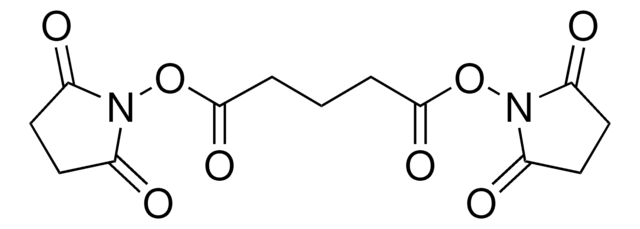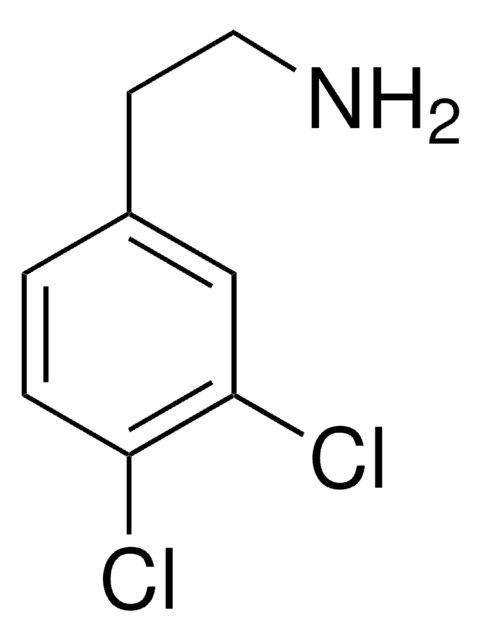Wszystkie zdjęcia(1)
Key Documents
803537
Bis(NHS)PEG5
Synonim(y):
Bis-N-succinimidyl-(pentaethylene glycol) ester, Bis-succinimide ester-activated PEG compound
Zaloguj sięWyświetlanie cen organizacyjnych i kontraktowych
About This Item
Wzór empiryczny (zapis Hilla):
C22H32N2O13
Numer CAS:
Masa cząsteczkowa:
532.50
Kod UNSPSC:
12352200
NACRES:
NA.22
Polecane produkty
Postać
liquid
Poziom jakości
masa cząsteczkowa
532.5
przydatność reakcji
reagent type: cross-linking reagent
warunki przechowywania
desiccated
rozpuszczalność
water: soluble
Warunki transportu
ambient
temp. przechowywania
−20°C
Powiązane kategorie
Opis ogólny
By contrast to typical PEG reagents that contain heterogeneous mixtures of different PEG chain lengths, this PEG reagent is a homogeneous compound of defined molecular weight and spacer arm length, providing greater precision in optimization and characterization of crosslinking applications. Homobifunctional crosslinkers containing N-hydroxysuccinimide (NHS) esters are often used for low-resolution 3-D studies of protein structure and protein interaction analysis.
Cechy i korzyści
- Reactive groups: NHS ester (both ends)
- Reactive towards: amino groups (primary amines)
- NHS esters react with—NH2 groups at pH 7-9, forming stable amide bonds
- Water-soluble; compare to non-pegylated BS3 (also soluble) and DSS (water-insoluble)
- Membrane-impermeable, allowing for cell surface labeling
- Irreversibly crosslink proteins or peptides by flexible PEG spacer arms
- Polyethylene glycol spacer arms help maintain conjugate solubility
- Pure compound with defined structure and molecular weight, ensuring reproducible protein-modification effects
- PEG spacer provides unique advantages, including increased stability, reduced tendency toward aggregation and reduced immunogenicity
- Ideal for small molecule or peptide conjugations
Przestroga
This product is sensitive to moisture. The vial is packaged in a resealable bag with a desiccant to reduce exposure to moisture. After cold storage, equilibrate the vial to room temperature before opening to reduce condensation inside the vial. Make fresh solutions. Storage of stock solutions is not recommended. After use, return the vial to the resealable bag. Close the bag and store the product at the recommended temperature.
This page may contain text that has been machine translated.
Kod klasy składowania
10 - Combustible liquids
Klasa zagrożenia wodnego (WGK)
WGK 3
Temperatura zapłonu (°F)
Not applicable
Temperatura zapłonu (°C)
Not applicable
Wybierz jedną z najnowszych wersji:
Certyfikaty analizy (CoA)
Lot/Batch Number
Nie widzisz odpowiedniej wersji?
Jeśli potrzebujesz konkretnej wersji, możesz wyszukać konkretny certyfikat według numeru partii lub serii.
Masz już ten produkt?
Dokumenty związane z niedawno zakupionymi produktami zostały zamieszczone w Bibliotece dokumentów.
Klienci oglądali również te produkty
S Knoller et al.
The Journal of biological chemistry, 266(5), 2795-2804 (1991-02-15)
The superoxide (O2-) forming NADPH oxidase complex of resting phagocytes can be activated in a cell-free system by certain anionic amphiphiles, such as sodium dodecyl sulfate (SDS). For O2- production to occur, the participation of both membrane-associated and cytosol-derived components
G W Cox et al.
Journal of immunology (Baltimore, Md. : 1950), 145(6), 1719-1726 (1990-09-15)
This study was designed to examine the expression and function of IL-2R on murine macrophages. We used a model system of murine macrophage cell lines (ANA-1 and GG2EE) that was established by infecting normal murine bone marrow-derived cells with the
G Mattson et al.
Molecular biology reports, 17(3), 167-183 (1993-04-01)
The various aspects of chemical crosslinking are addressed. Crosslinker reactivity, specificity, spacer arm length and solubility characteristics are detailed. Considerations for choosing one of these crosslinkers for a particular application are given as well as reaction conditions and practical tips
Nasz zespół naukowców ma doświadczenie we wszystkich obszarach badań, w tym w naukach przyrodniczych, materiałoznawstwie, syntezie chemicznej, chromatografii, analityce i wielu innych dziedzinach.
Skontaktuj się z zespołem ds. pomocy technicznej




![O,O′-Bis[2-(N-Succinimidyl-succinylamino)ethyl]polyethylene glycol 2,000](/deepweb/assets/sigmaaldrich/product/structures/161/408/20f7ade0-3e2e-4861-ae89-3d81c050059a/640/20f7ade0-3e2e-4861-ae89-3d81c050059a.png)






